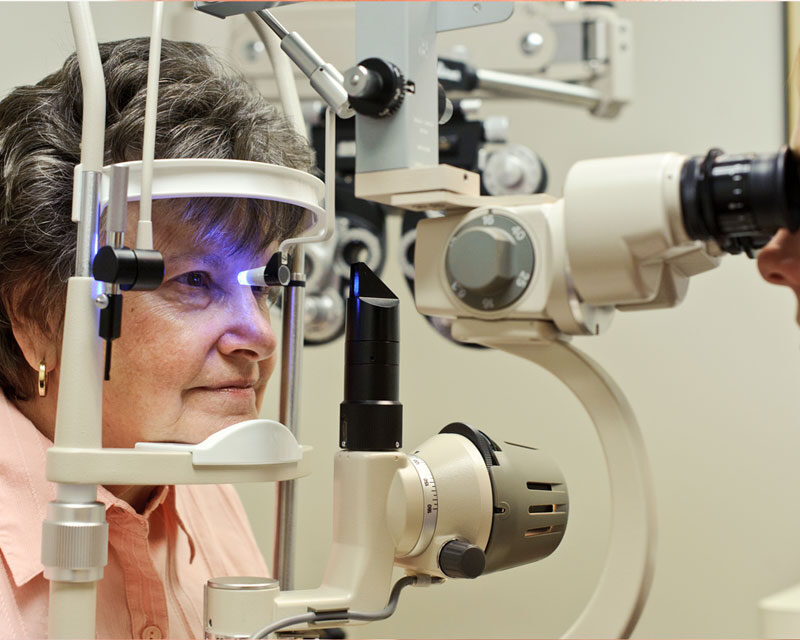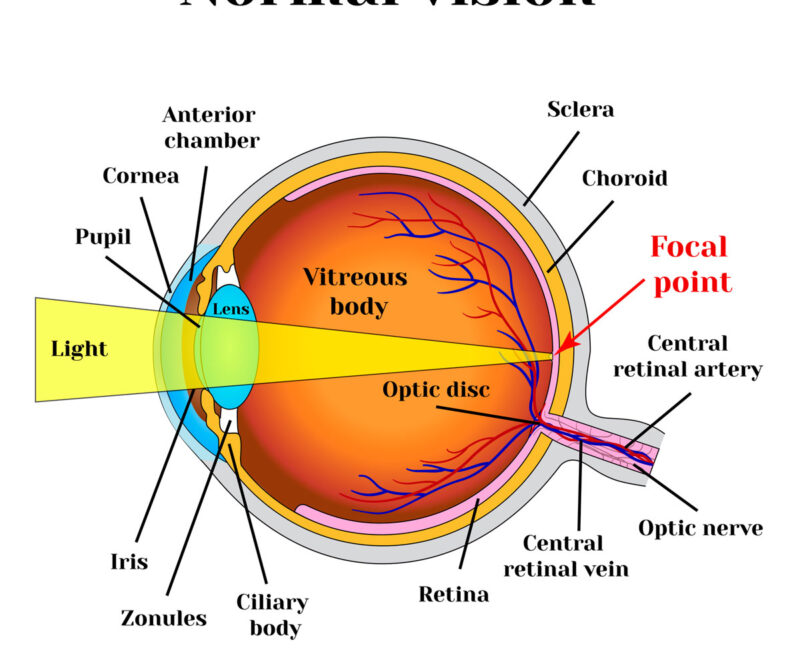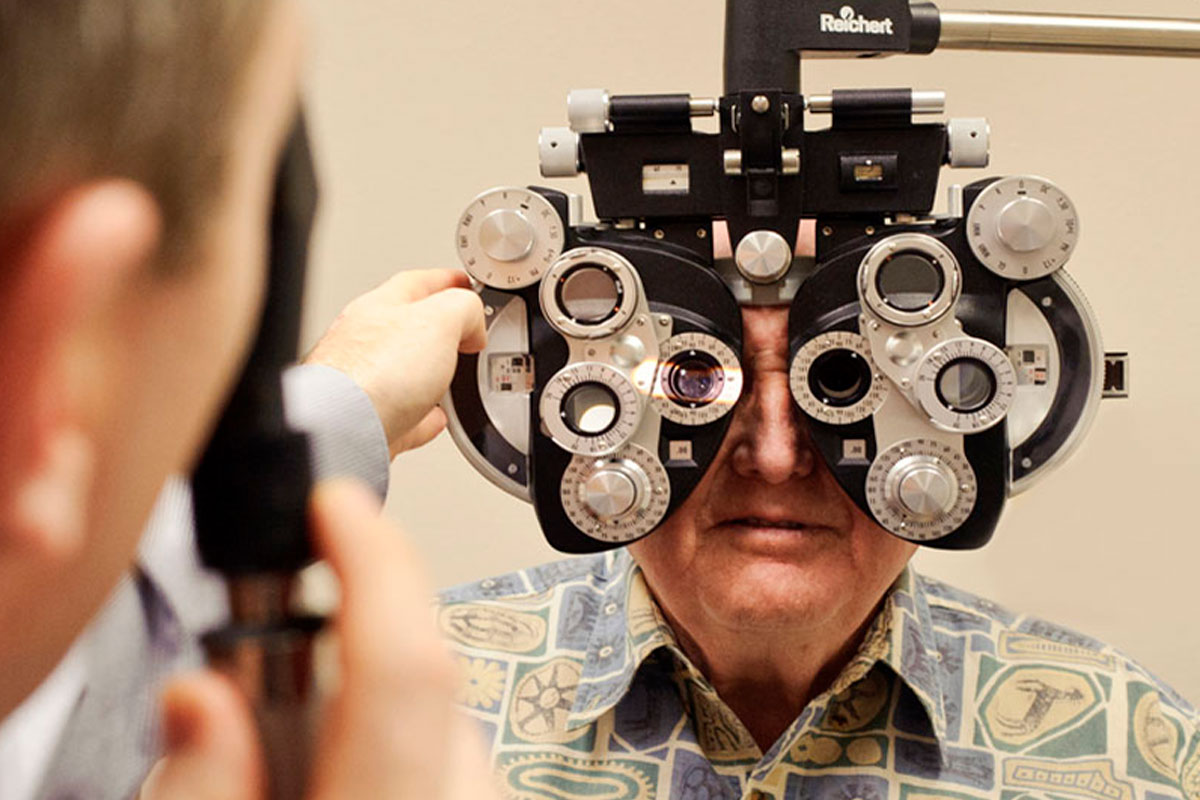
COMPREHENSIVE EYE EXAM
It may surprise you, that many people who see an eye doctor every year may not be receiving a comprehensive eye exam. A comprehensive eye exam also known as a dilated eye exam is necessary for an accurate evaluation of the eyes. When the eye is dilated Aaron J. Affleck, M.D. has the ability to examine the inside or more importantly the back of the inside of the eye. This part of your eye is call the fundus.
SLIT LAMP
Dr. Affleck will use a special microscope and light call a slit lamp along with a ophthalmoscope to examine your fundus. Some eye doctor pass on the dilated exam and take a picture of the fundus instead.
WHY FUNDUS PICTURE DON’T MEASURE UP
Fundus photography is when a specialized low-power microscope is attached to a camera. It then takes a picture of the back of the eye. Fundus photography has a place in eye care, but it should be used as documenting the progress of your eye disease or condition. Not in replace a fundus exam.
The first reason fundus photography should not replace a fundus exam is it NOT a 3-D image. Dr. Affleck paired with the ophthalmoscope is sensitive to detect subtle feature of eye diseases a camera can not tick up. Second, is the camera can not take a wide enough picture. Therefore, in order to cover all angles of the eye, multiple images must be manually overlapped to create a montage. This is becomes labor intense, time consuming and limited in accuracy.
What Is In This Article?
- COMPREHENSIVE EYE EXAM
- WHY FUNDUS PICTURES DON’T MEASURE UP
- DESCRIPTION & PROCESS
- LOOKING AT THE EYE CHART
- THE REFRACTION TEST
- WHAT IS SO IMPORTANT ABOUT HAVING AN ANNUAL REFRACTION TEST?
- NON-COVERED SERVICES
- THE DIFFERENCES AND SIMILARITIES
- COMMON QUESTIONS
- REASONS TO VISIT DR. AFFLECK
AN APPLE FOR LUNCH?

To further explain why a fundus picture should not replace a fundus exam. Lets think about of holding an apple.
First you look it over. It is not perfectly round. The skin has highlights and you can see speckles. You feel the weight in your hand. Maybe you want to eat the apple for lunch. Now, as you bring it to your lips, you can smell it, your teeth bite down and go through the crunchy peel. Your mouth explored with favor and juice.
WAIT- Now imagine the apple gone, instead, I hand you a picture of the apple. What good is a picture of an apple for lunch?
Description & Process
A thorough ophthalmic evaluation can detect common abnormalities of the visual system and its related structures as well as less common yet extremely serious issues. Such evaluations can also uncover evidence of systemic disease through its associated ophthalmic manifestations. With appropriate and timely intervention, visually impairing conditions such as cataract, and potentially blinding diseases such as glaucoma, age-related macular degeneration, and diabetic retinopathy often have favorable outcomes 1.
“Courtesy: National Eye Institute, National Institutes of Health (NEI/NIH)”
Getting an eye exam is an important part of staying healthy. A comprehensive eye exam is relatively simple and comfortable and shouldn’t take more than 60 to 90 minutes.
LOOKING AT THE EYE CHART
You will be asked to look at the eye chart to determine your visual acuity. This is the part of an eye exam people are probably most familiar with. Dr. Affleck will ask you to read a standardized eye chart to determine how well you see at various distances. The test is performed on one eye at a time by covering the eye not being tested. This test is more like a screening. When you do not have a 20/20 result it is time to move to a diagnosis test; The Refraction.
THE REFRACTION TEST
The refraction test, also termed vision test or refraction assessment, is an evaluation that tests an individual’s ability to see an object at a specific distance. The test involves looking through a device called a phoropter to read letters or recognize symbols on a wall chart through lenses of differing strength which are contained within the device. (During this process, Dr. Affleck will ask, “Which is better…one or two
The purpose of a refraction test is to measure the corrective vision enhancements each individual patient requires. In many ways, it is the most vital part of an annual eye exam. Think of the refraction test as the baseline upon which many other decisions are made. If Dr. Affleck can’t put corrective lenses in front of your eye so you see 20/20 there is something seriously wrong.
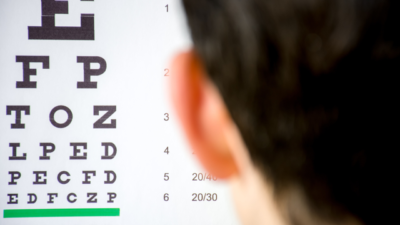
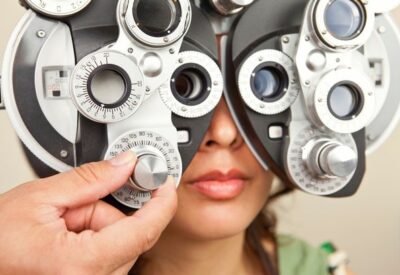
“Courtesy: National Eye Institute, National Institutes of Health (NEI/NIH)”
WHAT IS SO IMPORTANT ABOUT HAVING AN ANNUAL REFRACTION TEST?
A refraction test delivers at least three significant benefits.
- First, it provides Dr. Affleck with accurate and up-to-date information, which he can then use to provide you with the best corrected vision.
- Just as important, it enables him to identify any eye disease that requires treatment, which can then be expedited as quickly as possible.
- Finally, a refraction helps Dr. Affleck to track the eye health and ascertain whether any decline in vision is due to refractive error, or some other more serious issue.
DOES THE SAUCE TAST SALTY?

You watch as your friend sprinkles salt into tonight’s dinner of spaghetti sauces. Then he asks; “Does it taste salty?”
You think, this is odd, I must answer the question without tasting it, or smelling it, how can I make an accurate verdict?
One might argue that without allowing the proper evaluation it is impossible to answer the question.
UNDERSTAND
REFRACTION ASSESSMENTS
An important aspect of your exam is the refraction assessment. It detects deterioration, checks coordination and indicates the health of your eyes. It is necessary to adequately determine visual function and is important in determining if serious underlying eye problems exist. Tracking results from refraction assessments over time assists Dr. Affleck in determining and managing your care.
NON-COVERED SERVICES
In the ophthalmic medical world insurances like Medicare and commercial insurances have declared a refractive as a non-covered service. To them a Refraction test is a service that is not considered medically necessary. However, it is not how the medical community sees it! How can you examine the eyes without testing them?
This service is not optional and will be performed with your understanding that you are responsible for the charges.
THE DIFFERENCES AND SIMILARITIES
When Visiting With An Eye Doctor Who Cost More?
Hover Box Element
When using your medical insurance to cover your medical eye exam the cost will not differ between an ophthalmologist or optometrist.
The Benefits of Choosing an Ophthalmologist for Your Eye Care
Attaining his degree as a medical doctor allows Dr. Affleck professional insight to connect symptoms between your overall health and your optic health. His ability to diagnose a condition in another part of your body can directly inform him of issues with your vision. He has worked with and successfully treated patients of all ages throughout Eastern Idaho, helping them overcome their vision trouble.
Understanding the Difference Between Ophthalmology & Optometry
Optometric and ophthalmologic services differ in crucial ways, and Dr. Affleck is qualified to perform procedures helping patients requiring either school of medicine. An optometrist is able to perform eye exams, prescribe glasses and contacts, diagnose eye conditions and prescribe non-surgical treatments for those conditions. An ophthalmologist like Dr. Affleck is a medical doctor, and as such is able to practice surgical treatments for eye conditions, as well as perform all of the services of an optometrist. Dr. Affleck’s comprehensive training with top specialists in the field allows him to meet each patient’s eye care needs. By focusing on both surgical and non-surgical patients, Dr. Affleck ensures that patients receive complete, streamlined care and helps prevent “lesser issues” that can arise when an incomplete approach to eye care is delivered by other ophthalmologists.
Recommendation for when an adult should have a comprehensive medical eye examinations vary with age and risk factors. If you have not been seen by an ophthalmologist for an extended period of time or have never been examined it is typically recommended to receive an exam. At that point I can recommend the frequency of exams.
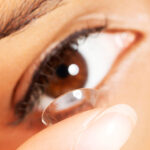
Your cornea shape can be changed from wearing contact lenses. Depending on the type of contact, it takes 2 to 8 weeks after you have stopped using them for the shape of the cornea to return to its natural state. Negative consequences can result from not leaving your contact lenses out long enough and your cornea not assuming its natural shape before treatment.
Yes, a vision (eye glass) prescription is a product from preforming an refraction test. While it is not the only reason for the test, we will provide you with a prescription after preforming this assessment if you paid for the test. The prescription is valid for 12 months after your test.
Yes, the formal term is a contact lens fitting. There are two items that must be done to receive a prescription for contact lenses. Frist, Dr. Affleck will need to preform a dilated exam either within 12 months or at the time of the fitting. Second, after receiving your trail lenses, you must return two weeks later for a review visit. Here, Dr. Affleck ensures they fit correctly.
You then can either order the contact lenses from us and we have the lenses mailed directly to your home. Or you can purchase elsewhere.
There is an additional charge fore contact lens fittings and we give a discount for patients who are previous wearers.
TERMS TO KNOW
Description:
Conjunctivitis or pink eye is an infection of the eye. If the small blood vessels become inflamed the white part of the eye appear reddish or pink. The discharge in the eye(s) may form a crust during the night. Therefore, in the morning this crust may prevent your eye(s) from opening.
Signs and Symptoms
Signs and Symptoms include but are not limited to:
- Red eyes
- Itching eyes
- Gritty feeling
- Discharge
- Tearing
How is it treated?
Pink eye can be caused by viruses, or bacteria. Prompt evaluation from Dr. Affleck can help identify proper management of the illness. Eye drops may be prescribed, and discontinued use of contact lenses may be advised. To limit the spread early diagnosis and treatment is helpful.
Description:
Diabetes can be harmful to optic health, because it can damage the eye’s blood vessels, resulting in diabetic retinopathy.
Dr. Affleck works with many patients with diabetes, providing yearly exams to catch diabetic retinopathy as soon as possible. He understands exactly how diabetes is affecting your eyes, and is able to help you learn to keep your diabetes under control.
Signs and Symptoms
- There are no early signs or symptoms for diabetic retinopathy. It is critical for diabetic to have comprehensive dilated early eye exams.
- Symptoms and signs in later stages of the condition is blurry vision, floating spots and blindness.
Description:
Dry eye is common among Idahoans. Some common reasons are the dryness from summer heat, the removal of moisture from Air Conditioner, or heaters in winter the quickly evaporate eye tears. this means it is difficult for eyes to stay wet. Others don’t make enough tears or quality of tears for their eyes.
Signs and Symptoms
Signs and symptoms may include but are not limited to:
- Sensation of stinging, burning or scratchy eyes
- Eye mucus
- Light sensitivity
- Redness
- Irritation
- Watery eyes
- Blurred vision
How is it treated?
Treatment is very individual. Dr. Affleck can provide relief in many ways. It all starts with an exam with Dr. Affleck. Some suggestions many be tear duct plugging, moisture eye drops, and eye drop medication.
Other many need Dr. Affleck to clean the eyelid glands and remove blockage of tears film.
What if no treatment is done?
Complications from dry eye many lead to eye infections, corneal ulcers, decreased vision and more.
Muscle surgery is used to correct a number of eye conditions, including amblyopia (lazy eye), esotropia (one eye turns inward), exotropia (one eye turns outward), and strabismus (crossed eyes). Many of these eye conditions develop in childhood. Sometimes, glasses can improve these conditions, but if non-invasive methods do not work, Dr. Affleck can successfully perform the required surgery. Many pediatricians in the area refer their patients to him. Because of this, Dr. Affleck is one of the most trusted area doctors in treating children with eye conditions.
Description:
Glaucoma is a condition in which fluid builds up in the optic nerve, creating increased pressure.
Signs and Symptoms
- Glaucoma is nicknamed the thief of sight. This is because early symptoms are often none until damage has happened.
- Later symptoms are loss of peripheral or side vision, blind spots and blindness.
How is it treated?
Many patients respond positively to eye drops or medications that are designed to reduce pressure in the optic nerve. Dr. Affleck can prescribe what he feels is the best treatment for you and will track your progress, adjusting your treatment plan as needed.
Some patient require procedures including lasers and/or surgery. Dr. Affleck can perform surgery to release the pressure.
What if no treatment is done?
The damage that results from this increased pressure can eventually result in blindness.
Description:
Macular degeneration is defined by a break down of the macula, which is inside the retina and allows us to focus our vision.
Signs and Symptoms
- Signs and Symptoms
How is it treated?
Unfortunately, there is no cure for macular degeneration, but Dr. Affleck provides methods of non-surgical treatment that help to slow down its progress. These include medications and injections. Keeping patients informed is an important step in treatment.
What if no treatment is done?
What if no treatment is done?
Dr. Affleck performs routine eye exams on patients of all ages. Using leading testing technology, he can diagnose not just nearsightedness and farsightedness, but a range of eye conditions, including glaucoma, cataracts, macular degeneration, strabismus, amblyopia, and more.
REFERENCES
-
NOV 2020 from AAO PPP Committee, Hoskins Center for Quality Eye Care


